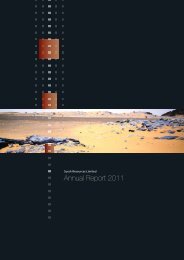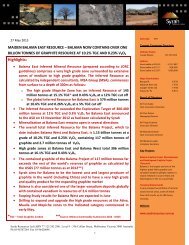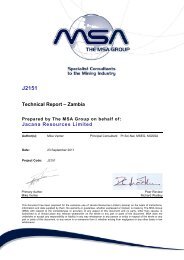Independent Geologist's Report Mozambique - Syrah Resources Ltd
Independent Geologist's Report Mozambique - Syrah Resources Ltd
Independent Geologist's Report Mozambique - Syrah Resources Ltd
You also want an ePaper? Increase the reach of your titles
YUMPU automatically turns print PDFs into web optimized ePapers that Google loves.
5.3 Mineralisation and Exploration model<br />
5.3.1 Uranium<br />
The Mavuzi Project includes the historical Mavuzi (Mavudzi) and Castro uranium<br />
mines, along with minor workings, pits, adits and trenching over the Mavuzi Airport and<br />
Kaboazi Creek occurrences. Uranium was discovered here in 1948, and mined at<br />
Mavuzi from 1950 until 1973. Mining produced 130t davidite at Mavuzi, with reported<br />
production between 1948 and 1950 of 50t U 3 O 8 . Total production for the period<br />
between 1950 and 1973 is not known. According to Lächelt (2004), 42t of davidite was<br />
produced from Castro, with an estimated reserve (presumed non-compliant) of 468t<br />
davidite calculated. The civil war in <strong>Mozambique</strong> led to the abandonment of the mine in<br />
1973. Evidence of mine houses, sports facilities, workings and existence of an airstrip<br />
are considered indicative of considerable activity during this period.<br />
Davidite (La,Ce,Ca)(Y,U)(Ti,Fe)20O 38 ) is the principal uranium ore recognised to date<br />
in the Mavuzi area and occurs in highly scapolitised and carbonatised host rocks in<br />
association with molybdenite, rutile, sphene and tourmaline. Davidite is a uranium<br />
bearing ilmenite with a nominal concentration of 9% U 3 O 8 . Rutile is observed to occur<br />
through the dolomite while davidite occurs on the quartz-dolomite margins. It occurs as<br />
crystals up to several centimetres in size and is hosted within steeply dipping and<br />
anastomosing lodes and shears (Figure 5-4). At the Mavuzi mine in particular, the<br />
orebodies were accessed via a series of adits and shafts up to 450m long and 25m<br />
deep respectively (Figure 5-4). It is envisaged that lower grade, disseminated davidite<br />
mineralisation forms a halo around these lozenge-shaped high grade lodes. Due to a<br />
lack of historical production records, the depth potential of the Mavuzi mineralisation<br />
has not been established.<br />
The so called Mavuzi Fault represents a north-north-easterly striking fault corridor that<br />
has an extent of 7km x 2km. The fault zone contains shear zone-hosted, vein style<br />
davidite mineralisation that appears to have a cross-cutting relationship to a variety of<br />
Tete Complex rocks including gabbros, anorthosites, calc-silicates and gneisses at<br />
Mavuzi and Castro as well as at other identified occurrences - Kaboazi Creek,<br />
Inhatobui and Mavuzi Airport. The davidite mineralisation occurs as late-stage potassic,<br />
carbonate silica replacements and disseminated uranium-iron oxides. Prominent<br />
clusters of coarse molybdenite (MoS 2 ) located within orangey coarse grained<br />
carbonates occur within the same structures, although not normally associated with the<br />
davidite (Figure 5-4).<br />
Geological mapping, airborne and ground radiometrics completed by Omegacorp have<br />
validated that radiometric anomalies are coincident with and are aligned along several<br />
of the structures that characterise the Mavuzi fault corridor (Figure 5-2). These<br />
lineaments may therefore represent faults and dilational zones/feeder structures for the<br />
Jacana <strong>Resources</strong> – Technical <strong>Report</strong> - <strong>Mozambique</strong>– September 2011 Page: 16








